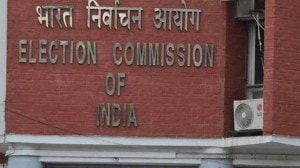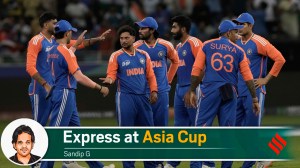What Mizoram, Goa’s ‘fully literate’ tag under the ULLAS program means
ULLAS is the latest adult literacy programme rolled out by the Indian government. It aims to equip 5 crore ‘non-literate individuals’ over the age of 15 with foundational literacy and numeracy skills.
 Women attend a literacy programme in Kerala. (Express archives)
Women attend a literacy programme in Kerala. (Express archives)Last month, Mizoram and Goa declared themselves to be “fully literate” states under ULLAS (Understanding Lifelong Learning for All in Society), a literacy programme for people over 15 who may not have attended school.
While Goa’s literacy rate was 99.72%, Mizoram’s stood at 98.2%. These states followed Ladakh, which was the first in the country to have declared itself “fully literate” under the scheme in June last year, having “achieved more than 97% literacy”.
What is the ULLAS scheme?
Launched by the Centre, the ULLAS scheme (also known as the New India Literacy Programme) is being implemented from 2022 to 2027. It aims to equip 5 crore ‘non-literate individuals’ over the age of 15 across the country with foundational literacy and numeracy skills, which means basic reading and writing and simple arithmetic learnt in primary classes. The teaching material is also meant to impart ‘critical life skills’ like financial and digital literacy.
Working with schools and officials, states and Union Territories have identified people who need such education through door-to-door surveys. They are then taught by registered volunteers – school students, students from higher education and teacher education institutions, and community members. The NCERT has developed the learning material, and the states have done it in their local languages. A mobile app is available for teaching and learning, but it can also be done offline.
ULLAS is the latest of the adult literacy programmes rolled out by the Indian government since the 1950s. This includes programmes targeting farmers and women in the 1960s and ’70s, and a country-wide programme called the National Adult Education Programme for the 15-35 age group. Then came the National Literacy Mission from 1988 to 2009 for this bracket.
The UPA government launched the ‘Saakshar Bharat’ (Literate India) scheme in 2009, and it ran until 2018. It equipped those aged 15 and above with functional literacy and was also linked to opportunities for skill development and further education. ULLAS also includes these goals.
How has the scheme fared so far?
Learners are administered the Functional Literacy Numeracy Assessment Test (FLNAT) – a 150-mark reading, writing and numeracy test, conducted in different languages. Upon passing the test, the learner is certified by the National Institute of Open Schooling (NIOS) as having acquired foundational literacy and numeracy.
An official in the Ministry of Education said that from March 2023 onwards, 1.77 crore people have appeared for FLNAT across 33 states/UTs. While the Centre provides the question paper, states contextualise it and translate it into local languages.
The ULLAS website says there are around 2.43 crore registered learners, and 1.03 crore people have been certified so far. Data from the tests conducted in 2024 show varying performance across states. In Tamil Nadu and Goa, 100% of those who appeared for FLNAT passed. The official said that nationally, on average, 90% of those who appear pass.
In last year’s tests, Gujarat and Tripura had a lower-than-average pass percentage – 87.07% and 75.97%, respectively. It stood at a little over 85% in Uttarakhand and Jharkhand, over 95% in Punjab, Assam and UP, and a little more than 99% in Delhi and Rajasthan.
In Jharkhand, Tamil Nadu, Punjab, Uttarakhand, and Mizoram, more than 70% of those who appeared for the test last year were women. This figure is over 65% in Odisha, UP, Assam, Rajasthan, Sikkim, and Delhi.
How is “full literacy” defined?
The Ministry of Education wrote to the states in August last year, defining “literacy” and “100% literacy” for ULLAS. Literacy was defined as “the ability to read, write, and compute with comprehension i.e to identify, understand, interpret and create, along with critical life skills such as digital literacy, financial literacy etc.”
It added that achieving 95% literacy in a State/UT may be considered equivalent to being fully literate. The communication also referred to the National Education Policy 2020, which calls for government initiatives for adult education to “expedite the all-important aim of achieving 100% literacy”. It mentioned the UN Sustainable Development Goals, which include ensuring that “all youth and a substantial proportion of adults, both men and women, achieve literacy and numeracy” by 2030. States were urged to strive towards this goal.
Goa, Mizoram, and Ladakh have said they surpassed the 95% literacy mark. Key to this is ensuring that people identified as non-literate after ULLAS take the FLNAT.
According to an SCERT official in Goa, data from 116 of the state’s panchayats and municipalities report literacy rates between 95% and 100%. In the remaining 89 panchayats/municipalities/ municipal corporations, the state identified 6,299 non-literate people, and under ULLAS, 2,136 were trained and cleared FLNAT.
Not all identified people could be trained. Several were elderly and could not or did not want to participate, the official said. “At the panchayat level, over 80 panchayats declared themselves to be 100% literate after conducting a survey. Considering the population from the last census, and the non-literate people who were identified (under ULLAS), the literacy rate of 99.72% was arrived at,” the official said.
In Mizoram, an SCERT official pointed to data from the Periodic Labour Force Survey (PLFS). The 2023-24 PLFS annual report shows a literacy rate of 98.2% among those aged 7 and above. Mizoram identified 3,026 non-literate people in 2023, and 1,692 were trained under ULLAS.
Ladakh had identified over 32,000 non-literate people under ULLAS. Around 7,300 learners appeared for FLNAT in Ladakh in the first phase, then over 22,000 in the second phase in 2023, and over 4,600 in the third phase in early 2024. In June 2024, it was declared ‘fully literate’ under ULLAS.
What do other surveys show?
According to the 2023-24 PLFS report, Goa has a literacy rate of 93.6%, while Ladakh has a literacy rate of 81% among those aged 7 and above. PLFS identifies a person who can both read and write a simple message with understanding in at least one language as ‘literate’.
The 2011 census reported a national average literacy rate of 74.04%, and an adult literacy rate (of those aged 15 and above) of 69.3%, up from 61% in 2001. This translates to 25.76 crore non-literate individuals, comprising 9.08 crore males and 16.68 crore females.
In the 2011 census, Goa had a literacy rate of 88.7%, while Mizoram recorded 91.3%. The highest figure of 94% was recorded in Kerala.
At an event last year, School Education Secretary in the Ministry of Education, Sanjay Kumar, said: “We are trying that in those States where literacy levels are high, we can try and make them 100% literate via ULLAS. According to the figures I have with me, there is Goa, Mizoram, Daman & Diu and Dadra & Nagar Haveli, Chandigarh, Lakshadweep, Andaman and Nicobar Islands, Puducherry.”
Photos



- 01
- 02
- 03
- 04
- 05


































